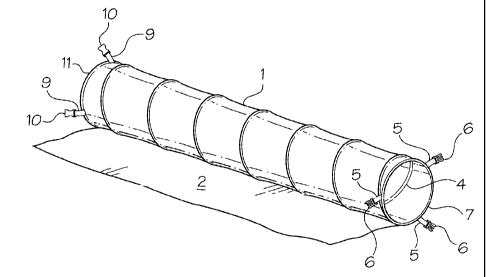Some of the information on this Web page has been provided by external sources. The Government of Canada is not responsible for the accuracy, reliability or currency of the information supplied by external sources. Users wishing to rely upon this information should consult directly with the source of the information. Content provided by external sources is not subject to official languages, privacy and accessibility requirements.
Any discrepancies in the text and image of the Claims and Abstract are due to differing posting times. Text of the Claims and Abstract are posted:
| (12) Patent: | (11) CA 2495976 |
|---|---|
| (54) English Title: | FLUID FLOW CONTROL BARRIER |
| (54) French Title: | BARRIERE DE CONTROLE DE DEBIT DE LIQUIDE |
| Status: | Granted |
| (51) International Patent Classification (IPC): |
|
|---|---|
| (72) Inventors : |
|
| (73) Owners : |
|
| (71) Applicants : |
|
| (74) Agent: | BORDEN LADNER GERVAIS LLP |
| (74) Associate agent: | |
| (45) Issued: | 2012-08-21 |
| (22) Filed Date: | 2005-02-02 |
| (41) Open to Public Inspection: | 2006-08-02 |
| Examination requested: | 2009-07-22 |
| Availability of licence: | N/A |
| (25) Language of filing: | English |
| Patent Cooperation Treaty (PCT): | No |
|---|
| (30) Application Priority Data: | None |
|---|
A barrier primarily intended as a silt dam includes a tubular body with a
planar
skirt extending outwardly from one side thereof for anchoring the barrier to
the
ground. A helical spring in the body biases the body to an elongated,
extended, use
position. The body can be collapsed and held in a compact condition for
storing or
transporting of the barrier by straps on the ends of the body and releasably
interengageable buckles on the straps
Une barrière destinée à servir principalement de barrage de limon comprend un corps tubulaire avec une jupe plane s'étendant vers l'extérieur d'un côté pour ancrer la barrière au sol. Un ressort hélicoïdal dans le corps sollicite ce corps pour qu'il prenne une position d'utilisation sortie allongée. Ce corps peut être rentré et maintenu à l'état compact pour ranger ou transporter la barrière au moyen de courroies, aux extrémités du corps tubulaire, et de boucles qui s'engagent mutuellement de manière libérable sur les courroies.
Note: Claims are shown in the official language in which they were submitted.
Note: Descriptions are shown in the official language in which they were submitted.

For a clearer understanding of the status of the application/patent presented on this page, the site Disclaimer , as well as the definitions for Patent , Administrative Status , Maintenance Fee and Payment History should be consulted.
| Title | Date |
|---|---|
| Forecasted Issue Date | 2012-08-21 |
| (22) Filed | 2005-02-02 |
| (41) Open to Public Inspection | 2006-08-02 |
| Examination Requested | 2009-07-22 |
| (45) Issued | 2012-08-21 |
| Abandonment Date | Reason | Reinstatement Date |
|---|---|---|
| 2007-02-02 | FAILURE TO PAY APPLICATION MAINTENANCE FEE | 2007-04-17 |
Last Payment of $229.50 was received on 2021-02-17
Upcoming maintenance fee amounts
| Description | Date | Amount |
|---|---|---|
| Next Payment if small entity fee | 2023-02-02 | $253.00 |
| Next Payment if standard fee | 2023-02-02 | $624.00 |
Note : If the full payment has not been received on or before the date indicated, a further fee may be required which may be one of the following
Patent fees are adjusted on the 1st of January every year. The amounts above are the current amounts if received by December 31 of the current year.
Please refer to the CIPO
Patent Fees
web page to see all current fee amounts.
Note: Records showing the ownership history in alphabetical order.
| Current Owners on Record |
|---|
| BMP SUPPLIES INC. |
| Past Owners on Record |
|---|
| LINDEMULDER, JIM |